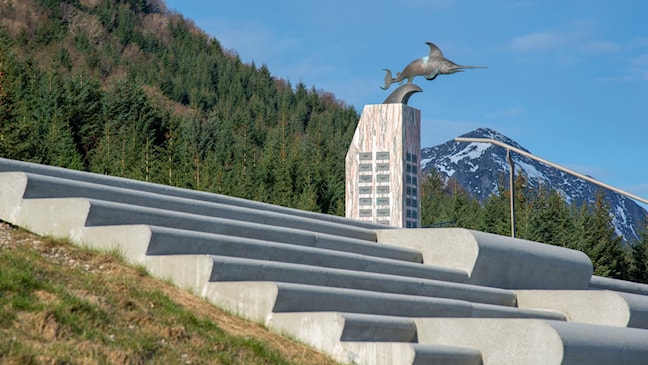Inge Dahlman - Asplan Viak
Grønsvik kystfort
Grønsvik coastal fort is located in Lurøy Municipality with a view towards the Helgeland archipelago.
- Landscape architect:
- Inge Dahlman - Asplan Viak
- Finished:
- 2020

The fort covers an area of approx. 87 000 m2 and consists of a number of gun positions, bunkers, mountain halls, close defence positions and barracks. The intention behind the project was to enhance and support the location of the museum and the coastal fort in the landscape, linking the current parking areas and the museum's outdoor areas together to create unity.
The access to the museum has been upgraded with a new parking and picnic area that welcomes arriving visitors. The design emphasises the interface between the museum and the location of the coastal fort, in order to attract visitors’ attention and invite them to check out the museum. The previous function of the place as a picnic area has been downplayed, and tables and seats are only found in the zone in front of the museum.
Walkways and signage facilitate public access. The beautiful coastal landscape, along with the museum, the fort and the outdoor area, form a great setting for the historic backdrop that this attraction represents.
Mortensnes
Mortensnes/ Ceavccageadgi cultural heritage area is situated on a wide open plain by the Varanger fiord.
- Landscape architect:
- Inge Dahlman - Asplan Viak
- Finished:
- 2021

People have lived here for more than 10,000 years and the place is one of the most important and richest cultural heritage areas in Europe, where history is readable from the landscape due to the post-glacial rebound process.
A network of specially prepared trails show traces of settlements from the Neolithic Period, a large pre-Christian burial ground, sacrificial sites, trapping pits and various other trapping systems.
Mortensnes is a sacred place. Mortensnes and the landscape in general is animated according to Sami culture and beliefs. In the upgrading of Mortensnes, it has therefore been important to create a low-key facility that submits to the landscape, while at the same time underlining the qualities and history of the landscape.
Passage through the area is organised and visitors are provided with a brief description of the area’s history, Sami culture and the attractions available. All interventions in the landscape are outside the protected area.
The car park is demarcated by a long, rounded concrete edge that serves as a terrace and a portal to the heritage area and the landscape. From here the view is good and it is easy for visitors to find their way. On the terrace you will find simple benches and necessary information about the place.
Up to the museum runs a simple walkway built in rough wooden planks that have been naturally impregnated and will remain there for many years. Through the terrain there are specially prepared trails. Simple and soberly shaped benches inspired by driftwood have been placed at strategic vantage points in the museum area.
At the highest point in the landscape is the post-glacial rebound installation, illustrating the changes in settlements and shorelines over thousands of years.
Nesseby municipality owns the museum building and its car park, the Sami Parliament manages the cultural heritage in the area, and Varanger Sami Museum is in charge of everyday operations and management.
Ureddplassen
Ureddplassen can be accessed from the east or from the west.
- Architect:
- Haugen/Zohar Arkitekter
- Landscape architect:
- Inge Dahlman - Asplan Viak
- Finished:
- 2018

Ureddplassen can be accessed from the east or from the west. If you come from the west, you will be looking towards the inner end of the fiord, at green mountain sides and rocky peaks. When you arrive from the east, you will have a wide view of the sea and the horizon.
Ureddplassen was already an established rest area with a war memorial to the sinking of the submarine “Uredd”. The rest area is also a popular destination among local residents and tourists alike, coming to see the midnight sun or the northern lights.
The new rest area has been furnished with a wide viewing terrace in concrete. A wide set of steps, alternately for walking and seating, leads down to the beach area. The view from the steps is expansive, and the seating is well protected from traffic noise. What is unique about the design is that all concrete elements have soft, rounded shapes instead of straight edges. The soft lines continue in a wave-shaped concrete toilet building framing the view towards the north. The walls are of glass that is lit in the dark. The terrace has been furnished with seating benches in the characteristic marble from Fauske. The base of the monument is made of the same material and is well placed.
The sevice building is designed ba Haugen/Zohar Arkitekter
The rest area is designed by Landskapsfabrikken AS - Inge Dahlman